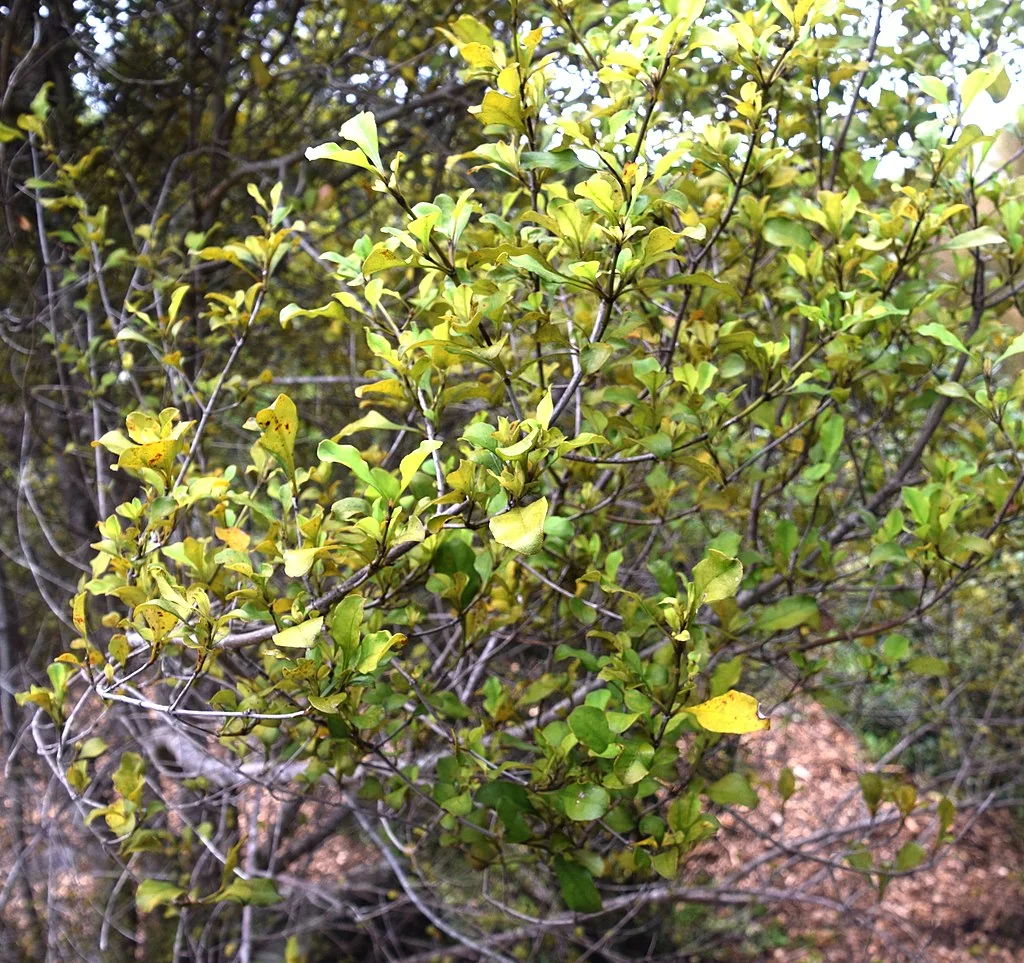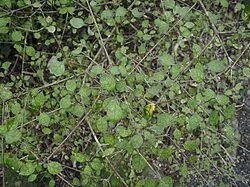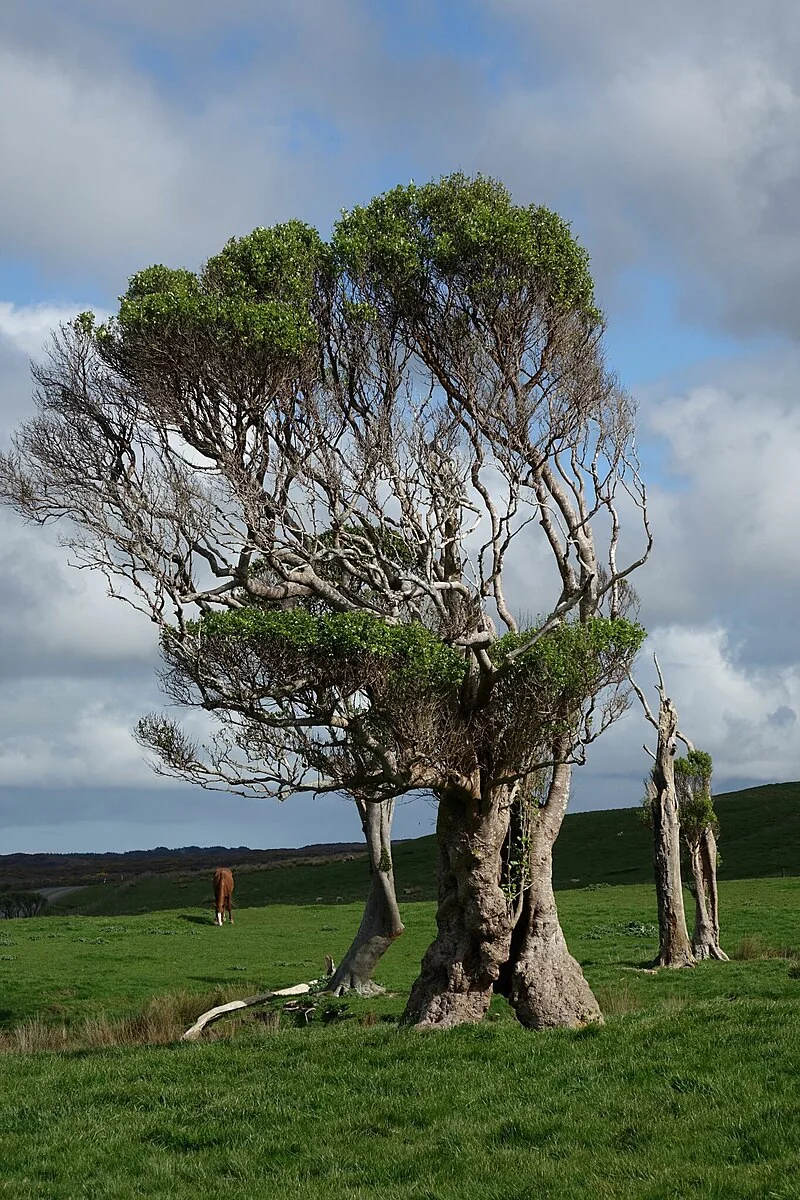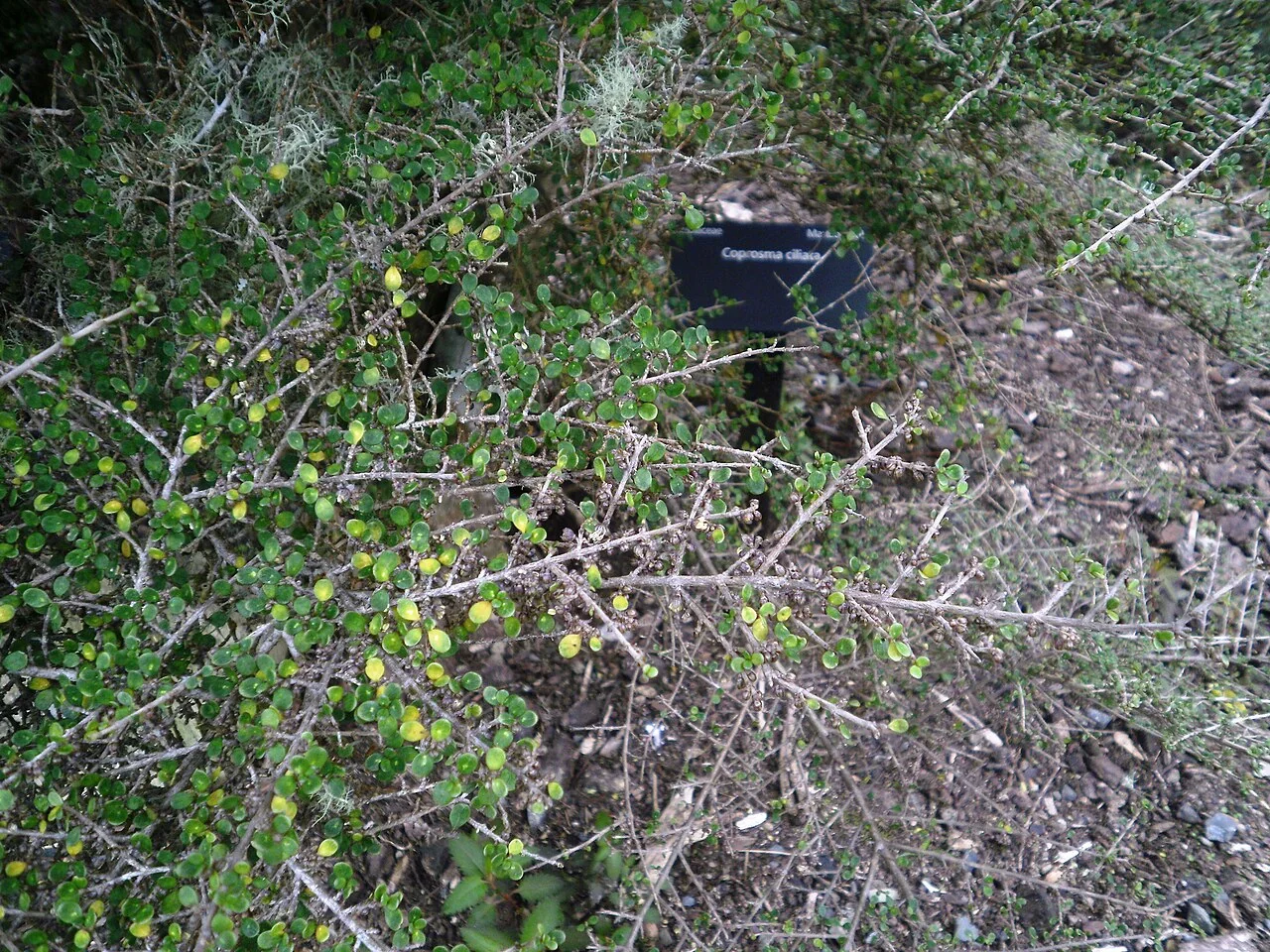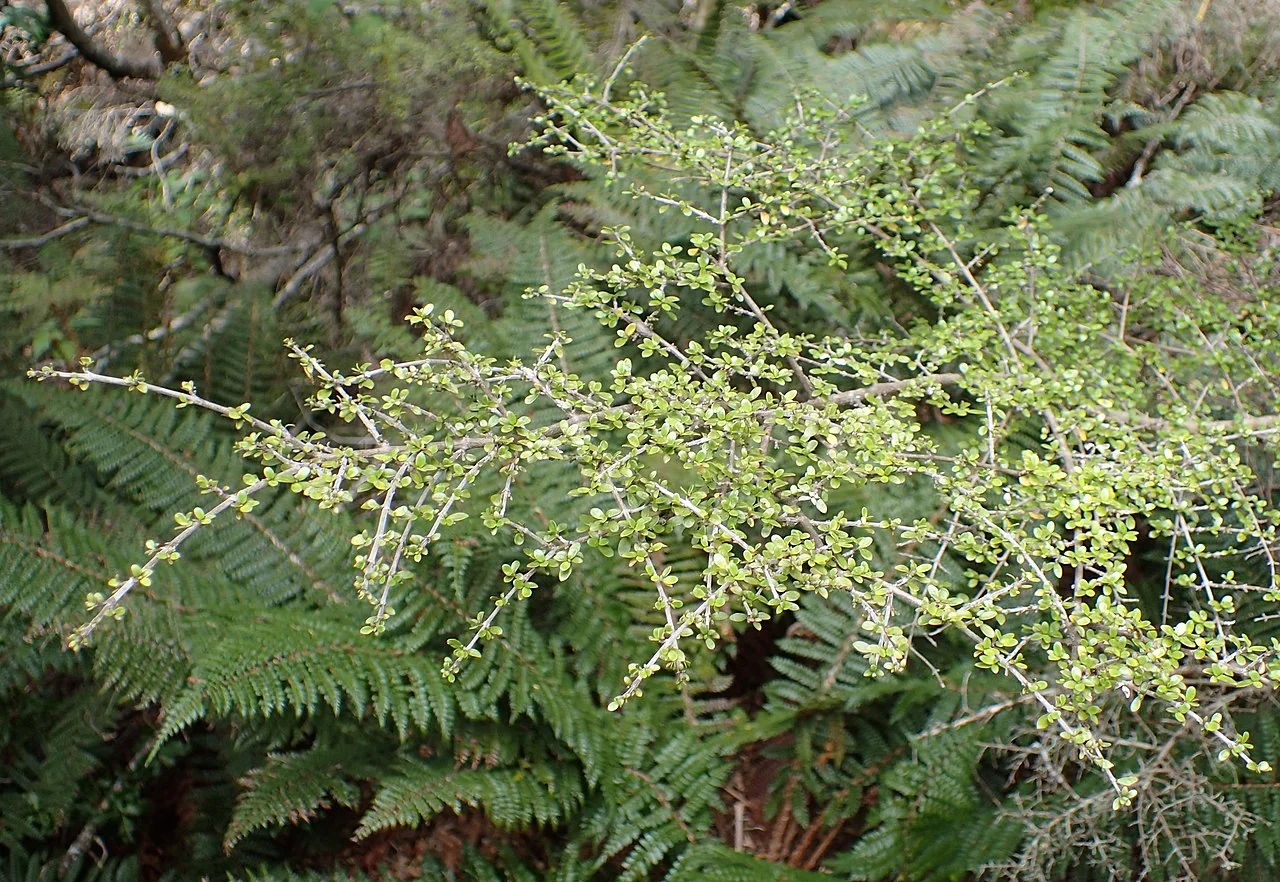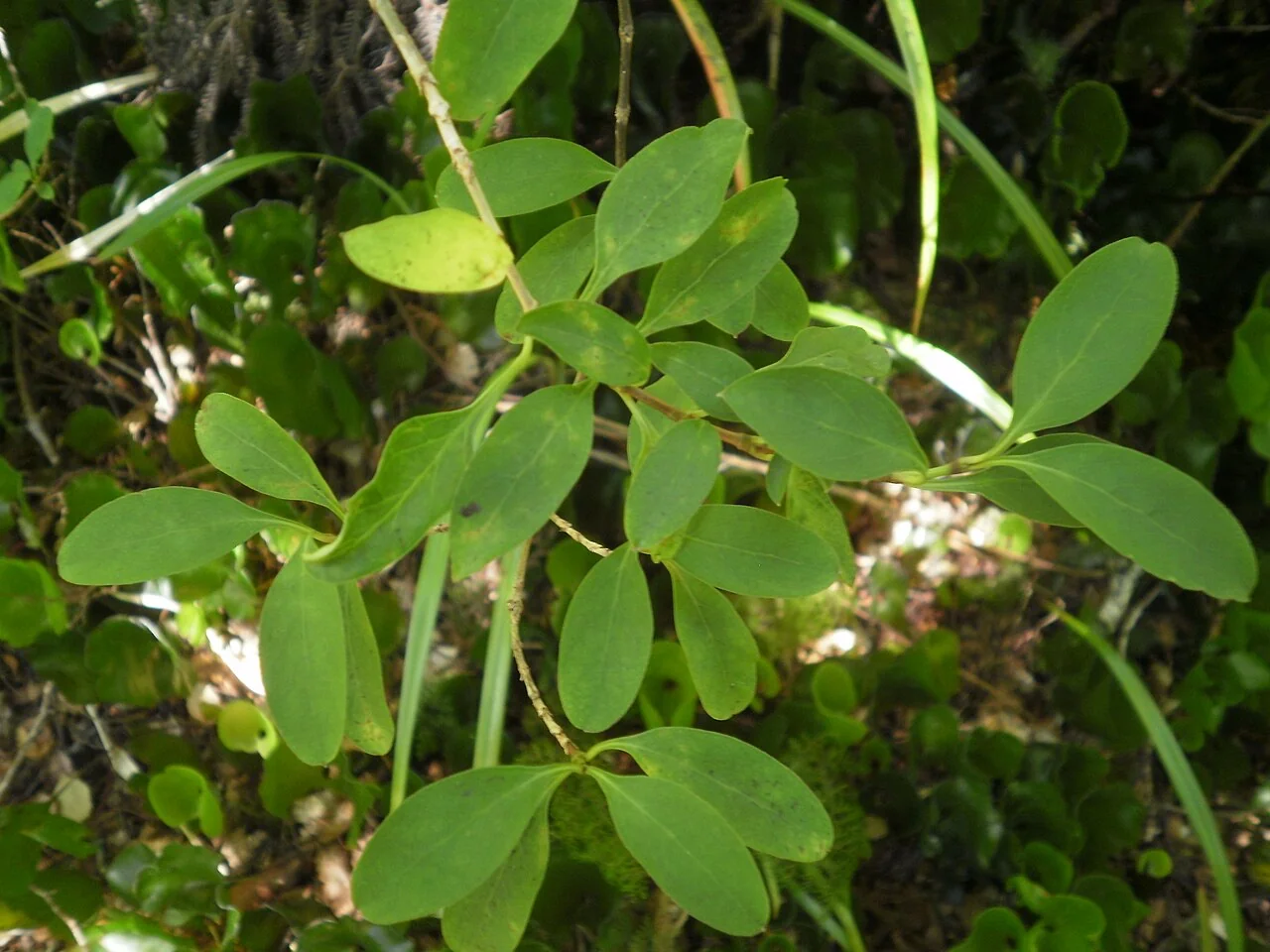
Swamp Coprosma
Coprosma tenuicaulis
Swamp Coprosma ( Coprosma tenuicaulis ), known as hukihuki in Te Reo Māori, represents one of New Zealand's most specialized wetland plants , uniquely adapted to thrive in permanently saturated soils where few other woody plants can survive. This slender, graceful shrub typically reaches 1-3 meters in height, distinguished by its characteristic interlacing network of thin, often wiry branches that create an open, airy canopy perfectly suited to wetland environments. The small, rounded leaves, measuring just 8-13mm in length, display a distinctive mottled appearance with darker green margins contrasting against lighter central areas, an adaptation that helps maximize photosynthesis in the often shaded conditions of swamp environments. Unlike its more robust Coprosma relatives, this species has evolved specifically for life in boggy conditions, with specialized root systems capable of extracting nutrients from waterlogged, oxygen-poor soils. The plant's inconspicuous flowers appear in early spring, followed by small dark berries that ripen between February and June, providing crucial food resources for wetland birds during times when other food sources may be scarce. Found naturally in swamps, wet hollows, poorly drained shrublands, and riparian zones throughout New Zealand's lowland areas, Swamp Coprosma plays a vital ecological role in wetland stability, helping to prevent erosion while creating microhabitats for specialized wetland fauna. Its ability to form dense colonies through natural spread makes it invaluable for wetland restoration projects, where it serves as both a pioneer species and a long-term structural component of healthy bog ecosystems.

Plant Description
Botanical Features
Coprosma tenuicaulis , commonly known as Swamp Coprosma or hukihuki, is a slender, graceful evergreen shrub endemic to New Zealand, uniquely adapted to thrive in permanently saturated soils. It typically reaches 1-3 meters in height, distinguished by its characteristic interlacing network of thin, often wiry branches. The small, rounded leaves, measuring just 8-13mm in length, display a distinctive mottled appearance with darker green margins contrasting against lighter central areas. It produces inconspicuous white flowers in early spring, followed by small dark reddish-black to black berries that ripen between February and June. This species is found naturally in swamps, wet hollows, poorly drained shrublands, and riparian zones throughout New Zealand's lowland areas, playing a vital ecological role in wetland stability and providing food for wetland birds.
Quick Facts
| Scientific Name | Coprosma Tenuicaulis |
|---|---|
| Height | 0.5-2 m |
| Spread | 1-3 m |
| Water Needs | Very high |
| Light | Full sun to part shade |
| Frost Tolerance | Moderate |
| Salt Tolerance | Poor |
| Growth Rate | Moderate |
| Lifespan | Long |
Climate Best Suited to
Swamp Coprosma ( Coprosma tenuicaulis ) thrives in wet, boggy conditions and areas with permanent moisture. It adapts well to typical New Zealand growing conditions with appropriate care and positioning.
Regional Suitability
| Whangārei | Ideal |
| Auckland | Ideal |
| Hamilton | Suitable |
| Rotorua | Suitable |
| Tauranga | Ideal |
| Gisborne | Ideal |
| New Plymouth | Ideal |
| Whanganui | Ideal |
| Palmerston North | Suitable |
| Napier | Ideal |
| Wellington | Ideal |
| Nelson | Ideal |
| Christchurch | Suitable |
| Dunedin | Suitable |
| Invercargill | Suitable |
| City | Climate Suitability |
|---|
Natural Habitat
Swamp Coprosma ( Coprosma tenuicaulis ) is a true wetland specialist, uniquely adapted to the waterlogged soils of New Zealand's swamps, bogs, and fens. Its natural habitat consists of permanently wet ground, often in lowland areas, where it can be found in poorly drained shrublands, along the margins of streams and lakes, and in riparian forests. This species is so well-adapted to wet conditions that it can even be found growing in shallow, standing water up to 30 cm deep. It is distributed across both the North and South Islands, from Kaitaia in the north to Okarito on the West Coast. While it is most at home in saturated soils, it can also tolerate a range of other conditions, including full sun and partial shade, as long as its roots have access to ample moisture. This makes it a vital component of wetland ecosystems and an important species for riparian restoration projects.
Plant Conservation
Coprosma tenuicaulis , also known as swamp coprosma or hukihuki, is classified as "Not Threatened" as of 2023. This status is based on the New Zealand Threat Classification System (NZTCS). Previous assessments in 2012 and 2017 also listed it as "Not Threatened".
This native shrub is endemic to New Zealand, found in both the North and South Islands. It typically grows in lowland swamps, boggy ground, poorly drained shrubland, and riparian forests.
Growing Requirements
Soil Requirements
Swamp Coprosma ( Coprosma tenuicaulis ) performs best in well-draining soil that retains adequate moisture. Like most New Zealand natives, it prefers soils that don't become waterlogged but maintain consistent moisture levels. Good drainage is essential for healthy root development.
- Well-draining soil essential for healthy growth
- Prefers consistent moisture without waterlogging
- Adapts to various soil types with good drainage
- Benefits from organic matter incorporation
- Mulching helps retain moisture and suppress weeds
Light Requirements
Swamp Coprosma ( Coprosma tenuicaulis ) performs well in full sun to partial shade conditions. Like many New Zealand natives, it adapts to various light conditions but typically shows best growth and form in positions that receive adequate sunlight throughout the day.
- Full sun to partial shade positions
- At least 4-6 hours of direct sunlight daily
- Tolerates light shade in warmer climates
- Morning sun particularly beneficial
Water Requirements
Swamp Coprosma ( Coprosma tenuicaulis ) requires regular watering during establishment, typically for the first 1-2 years. Once established, it becomes more drought-tolerant but benefits from consistent moisture during dry periods. Avoid overwatering which can lead to root problems.
- Regular watering during establishment phase
- Moderate drought tolerance once established
- Consistent moisture during dry periods beneficial
- Avoid waterlogged conditions
- Mulching helps conserve soil moisture
Planting Guide
When to Plant
The best time to plant Coprosma tenuicaulis is from early spring through autumn, as warmer soil and ample moisture create optimal conditions for root establishment.
Site Selection and Soil
- Sunlight: Prefers partial shade but can tolerate full sun exposure. Planting in full sun can lead to darker leaf colouring and denser growth.
- Soil: Thrives in consistently moist, well-drained soil conditions and has a high tolerance for wet, boggy soils, reflecting its native habitat in swamps and lake margins. If the soil is heavy or clay-based, adding gypsum can improve drainage.
- Water: This plant requires regular watering, particularly during its first year after planting and during dry periods. Once established, it becomes more drought-tolerant.
- Temperature/Tolerances: Hardy and can tolerate moderate frost, cold climates, wind, and coastal environments. The ideal temperature range is between 20-38°C.
Planting Steps
- Dig a planting hole that is twice as wide and the same depth as the plant's root-ball.
- Gently remove the shrub from its container, tease out the roots, and trim any circled or tangled roots.
- Position the plant in the hole and backfill with soil, gently firming it down. Create a raised, doughnut-shaped ring of soil around the outer edge of the root zone to help retain water.
- Water thoroughly immediately after planting to settle the soil around the roots, and keep the soil moist for several weeks until the new plant establishes.
After Planting Care
Maintain consistent moisture, especially during establishment. Once established, water deeply once or twice a week, depending on weather conditions. Fertilize during the growing season (spring-summer) with a balanced fertilizer. During active growth, a high-nitrogen feed can be applied bi-monthly. Always water the soil before fertilizing to prevent root burn. Apply organic mulch, such as bark chips, woodchip, or pea straw, around the base of the plant, keeping it away from the stem. Winter is an ideal time for mulching.
Ecological Role
Environmental Benefits
Coprosma tenuicaulis , commonly known as swamp coprosma or hukihuki, is a native New Zealand shrub with several important ecological roles. It is typically found in wetland environments, including swamps, boggy ground, poorly drained shrubland, and riparian forests in both the North and South Islands of New Zealand. This plant can even grow in water up to 30 cm deep.
- Habitat and Food Source: Coprosma tenuicaulis provides food and habitat for various native birds and insects. The shrub produces dark reddish-black to black fruit with dark purple flesh, which ripens between February and June. These fruits are a valuable food source for birds, which in turn aid in seed dispersal. The plant's flowers, which are delicate and wind-pollinated, appear in early spring and also serve as a food source for bees.
- Ecosystem Stabilization and Restoration: Due to its preference for wet and poorly drained soils, Coprosma tenuicaulis is commonly used in riparian plantings and forest restoration projects. Its presence helps to stabilize these ecosystems, and by attracting birds, it can also contribute to the dispersal of other native seeds, thereby increasing biodiversity.
Uses and Significance
Garden Uses
- Excellent for native plant gardens and restoration
- Suitable for naturalistic landscape designs
- Low maintenance once established
- Contributes to local biodiversity
- Attractive to beneficial native wildlife
Cultural Significance
Traditional Uses and Values
Coprosma tenuicaulis , also known as Swamp Coprosma or Hukihuki, is a native New Zealand shrub with cultural and ecological significance. Its primary cultural significance lies in its Māori name, Hukihuki. Ecologically, the plant's dark reddish-black to black berries, which fruit between February and June, serve as a valuable food source for native birds. It also provides food for bees.
In modern contexts, Coprosma tenuicaulis is frequently utilized in landscaping and restoration efforts. It is a popular choice for riparian plantings, wetland gardens, and projects aimed at enhancing wildlife habitats, particularly in swampy or wet areas. Landscape designers appreciate its ability to add texture and visual interest to damp environments, and it can also be cultivated as a hedge. While other Coprosma species, such as Coprosma repens (taupata), have documented traditional Māori uses, direct records for Coprosma tenuicaulis are limited. Today it is chiefly valued for wetland restoration and riparian planting, where its fruits support wetland birds and its roots stabilize saturated soils.
Landscaping Uses
Garden Design Applications
Coprosma tenuicaulis , also known as Swamp Coprosma or Hukihuki, is a versatile New Zealand native shrub with several landscaping uses, particularly due to its adaptability to wet conditions. It can grow up to 3 meters tall, featuring slender, interlacing branches and small, rounded leaves.
- Wetland and Riparian Plantings: It thrives in wet, boggy soils found in swamps and lake margins, making it ideal for wetland gardens and riparian planting (along riverbanks or streams).
- Restoration Projects: It is commonly used in restoration projects, especially in swampy areas.
- Hedges and Screening: Coprosma tenuicaulis can be grown as an interesting hedge or for screening purposes.
- Adding Texture and Interest: Landscape gardeners often use this Coprosma to provide texture and visual interest in wet areas.
- Wildlife Habitats: The plant produces dark reddish-black to black berries between February and June, which serve as a valuable food source for birds, enhancing wildlife habitats.
- Mass Native Plantings: It is suitable for mass native plantings.
- Damp Conditions: It excels in damp conditions.
Seasonal Care Calendar
Spring
Spring is an active growth period for Swamp Coprosma ( Coprosma tenuicaulis ). New growth emerges and this is an ideal time for planting new specimens. Monitor soil moisture as temperatures warm and growth accelerates.
- Active growth period with new foliage development
- Ideal time for planting new specimens
- Monitor soil moisture as temperatures rise
- Apply organic mulch if needed
Summer
Summer is typically the main growing season for Swamp Coprosma ( Coprosma tenuicaulis ). Ensure adequate watering during hot, dry periods, especially for young plants. Established plants show good heat tolerance with appropriate care.
- Peak growing season with active development
- Monitor watering needs during hot weather
- Young plants need consistent moisture
- Established plants show good heat tolerance
Autumn
During autumn, Swamp Coprosma ( Coprosma tenuicaulis ) begins to slow its growth as temperatures cool. This is another good time for planting as conditions become more favorable. Reduce watering frequency but maintain soil moisture.
- Growth slows as temperatures moderate
- Good time for planting new specimens
- Reduce watering frequency gradually
- Maintain soil moisture without overwatering
Winter
Winter is typically a dormant period for Swamp Coprosma ( Coprosma tenuicaulis ), with minimal growth activity. Reduce watering but ensure plants don't completely dry out. Most New Zealand natives are cold-hardy and require minimal winter protection.
- Dormant period with minimal growth activity
- Reduce watering but avoid complete drying
- Generally cold-hardy in most New Zealand climates
- Minimal winter protection required
When to Prune and How Much
Swamp Coprosma ( Coprosma tenuicaulis ) generally requires minimal pruning to maintain its natural form and health. Most maintenance involves removing dead or damaged growth and light shaping if needed.
- Remove dead, damaged, or diseased growth as needed
- Light pruning to maintain shape if desired
- Prune after flowering if applicable
- Avoid heavy pruning which can stress the plant
- Use clean, sharp tools to prevent disease
- Most natives maintain good form without regular pruning
Always use clean, sharp tools when pruning to minimize disease risk. Native plants typically maintain their natural form well and often require less intervention than exotic species.
How to Grow Swamp Coprosma
Swamp Coprosma is a unique and highly specialized native shrub, perfectly adapted to thrive in permanently wet and boggy conditions where many other woody plants would fail. Its slender, interlacing branches and small, mottled leaves give it a distinctive appearance, making it an interesting addition to wetland gardens, bog gardens, and riparian planting schemes. While it requires consistent moisture, its resilience and ecological value make it a rewarding plant to cultivate, especially for those looking to restore native wetland habitats.
From Seed
Propagating Swamp Coprosma from fresh seed is a reliable method. Collect the small, dark berries when they are ripe, typically between February and June. Clean the seeds from the pulp and sow them immediately onto a well-draining seed-raising mix. Lightly cover the seeds with a thin layer of fine grit or sand. Maintain consistent moisture in the seed tray and provide warm, bright conditions for germination, ideally around 20-25°C. Germination usually occurs within 2-4 weeks. Once seedlings have developed a few true leaves and are large enough to handle, they can be carefully transplanted into individual pots and grown on in a sheltered, consistently moist environment before planting out into their final boggy location.
From Cuttings
Swamp Coprosma can also be successfully propagated from semi-hardwood cuttings. Take cuttings from healthy, current season's growth in late summer or early autumn. Cuttings should be about 4-6 inches long. Remove the lower leaves and, if desired, dip the cut end in a rooting hormone to improve success rates. Plant the cuttings into a well-draining cutting mix, such as a blend of perlite and peat or coarse sand. Maintain high humidity around the cuttings, perhaps by placing them under a plastic dome or in a propagator, and ensure consistent moisture in the cutting mix. Rooting usually occurs within 6-10 weeks. Once rooted, the new plants can be potted on and grown in a sheltered, moist environment until they are ready for planting.
Pests and Diseases
Coprosma tenuicaulis , also known as swamp coprosma, is generally considered largely disease resistant. However, it can be affected by certain pests and diseases:
Pests:
- Coprosma white erineum mite (Phyllocoptes coprosma): This gall mite is endemic to New Zealand and causes white hairs, known as erineum, on the underside of Coprosma leaves. It can also cause black or brown erineum on other Coprosma species. Some mite species can transmit plant viruses that may lead to plant diseases and death.
- Thrips: These insects damage plants by sucking their juices and scraping at leaves, flowers, and fruits, which can result in leaf death. Both native and exotic thrips species are found in New Zealand.
Diseases:
- Rust: While not specifically detailed for Coprosma tenuicaulis , other Coprosma species, such as Karamū, can be affected by rust. This fungal disease causes pale yellow, circular, or irregular spots on the underside of leaves, with yellow spots appearing on the upper surface. These spots eventually turn brown. Rust is generally not known to cause significant long-term damage to its host.
- Plant Viruses: Although Coprosma tenuicaulis is largely disease resistant, the Coprosma white erineum mite has the potential to transmit plant viruses that can cause diseases and even plant death.
Bonus Tip
Expert Growing Advice
Coprosma tenuicaulis is a true wetland specialist, able to grow in water up to 30 cm deep. Its slender, interlacing branches and small, rounded leaves give it a delicate appearance, but this plant is tough, tolerating frost, wind, and a range of soil conditions. Its dark berries are a favorite food of native birds.


